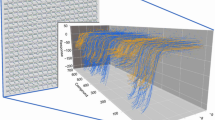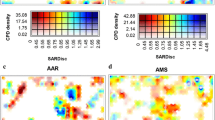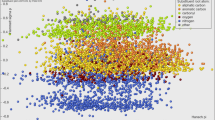Abstract
Compound optimization generally requires considering multiple properties in concert and reaching a balance between them. Computationally, this process can be supported by multi-objective optimization methods that produce numerical solutions to an optimization task. Since a variety of comparable multi-property solutions are usually obtained further prioritization is required. However, the underlying multi-dimensional property spaces are typically complex and difficult to rationalize. Herein, an approach is introduced to visualize multi-property landscapes by adapting the concepts of star and parallel coordinates from computer graphics. The visualization method is designed to complement multi-objective compound optimization. We show that visualization makes it possible to further distinguish between numerically equivalent optimization solutions and helps to select drug-like compounds from multi-dimensional property spaces. The methodology is intuitive, applicable to a wide range of chemical optimization problems, and made freely available to the scientific community.






Similar content being viewed by others
References
Stumpfe D, Bajorath J (2012) Methods for SAR visualization. RSC Adv 2:369–378
Wassermann AM, Wawer M, Bajorath J (2010) Activity landscape representations for structure-activity relationship analysis. J Med Chem 53:8209–8223
Shanmugasundaram V, Maggiora GM (2001) Characterizing property and activity landscapes using an information-theoretic approach. In: Proceedings of 222nd American chemical society national meeting, division of chemical information, Chicago, IL, August 26–30, 2001; American Chemical Society: Washington, D.C., 2001; abstract no. 77
Wawer M, Peltason L, Weskamp N, Teckentrup A, Bajorath J (2008) Structure-activity relationship anatomy by network-like similarity graphs and local structure-activity relationship indices. J Med Chem 51:6075–6084
Wollenhaupt S, Baumann K (2014) inSARa: Intuitive and interactive SAR interpretation by reduced graphs and hierarchical MCS-based network navigation. J Chem Inf Model 54:1395–1409
Agrafiotis DK, Shemanarev M, Connolly PJ, Farnum M, Lobanov VS (2007) SAR maps: a new SAR visualization technique for medicinal chemists. J Med Chem 50:5926–5937
Wassermann AM, Bajorath J (2012) Directed R-group combination graph: a methodology to uncover structure-activity relationship patterns in a series of analogues. J Med Chem 55:1215–1226
Peltason L, Weskamp N, Teckentrup A, Bajorath J (2009) Exploration of structure-activity relationship determinants in analogue series. J Med Chem 52:3212–3224
Wawer M, Bajorath J (2010) Similarity-potency trees: a method to search for SAR information in compound data sets and derive SAR rules. J Chem Inf Model 50:1395–1409
Peltason L, Iyer P, Bajorath J (2010) Rationalizing three-dimensional activity landscapes and the influence of molecular representations on landscape topology and the formation of activity cliffs. J Chem Inf Model 50:1021–1033
Reutlinger M, Guba W, Martin RE, Alanine AI, Hoffmann T, Klenner A, Hiss JA, Schneider P, Schneider G (2011) Neighborhood-preserving visualization of adaptive structure-activity landscapes: application to drug discovery. Angew Chem Int Ed 50:11633–11636
Zwierzyna M, Vogt M, Maggiora GM, Bajorath J (2015) Design and characterization of chemical space networks for different compound data sets. J Comput-Aided Mol Des 29:113–125
Ertl P, Rohde B (2012) The molecule cloud-compact visualization of large collections of molecules. J Cheminf 4:12
Awale M, van Deursen R, Reymond J-L (2010) MQN-mapplet: visualization of chemical space with interactive maps of DrugBank, ChEMBL, PubChem, GDB-11, and GDB-13. J Chem Inf Model 50:1395–1409
Reymond J-L (2015) The chemical space project. Acc Chem Res 48:722–730
Kireeva N, Baskin II, Gaspar HA, Horvath D, Marcou G, Varnek A (2012) Generative topographic mapping (GTM): universal tool for data visualization, structure-activity modeling, and dataset comparison. Mol Inf 3(4):301–312
Wermuth CG (2008) The practice of medicinal chemistry, 3rd edn. Academic Press-Elsevier, Burlington, London
Gillet VJ, Khatib W, Willett P, Fleming P, Green DVS (2002) Combinatorial library design using multiobjective genetic algorithm. J Chem Inf Comput Sci 42:375–385
Gillet VJ (2004) Applications of evolutionary computation in drug design. Struct Bond 110:133–152
Nicolaou CA, Brown N, Pattichis CS (2007) Molecular optimization using computational multi-objective methods. Curr Opin Drug Discov Develop 10:316–324
Gaulton A, Bellis LJ, Bento AP, Chambers J, Davies M, Hersey A, Light Y, McGlinchey S, Michalovich D, Al-Lazikani B, Overington JP (2012) ChEMBL: a large-scale bioactivity database for drug discovery. Nucleic Acids Res 40:D1100–D1107
Law V, Knox C, Djoumbou Y, Jewison T, Guo AC, Liu Y, Maciejewski A, Arndt D, Wilson M, Neveu V, Tang A, Gabriel G, Ly C, Adamjee S, Dame ZT, Han B, Zhou Y, Wishart DS (2014) DrugBank 4.0: shedding new light on drug metabolism. Nucleic Acids Res 42:D1091–D1097
OEChem TK (2012) OpenEye scientific software Inc, Santa Fe, NM, USA
Molecular Operating Environment (2012) Chemical computing group Inc.: Montreal, Quebec, Canada
Cook D, Buja A, Lee EK, Wickham H (2008) Grand tours, projection pursuit guided tours and manual controls. In: Chen C, Härdle W, Unwin A (eds) Handbook of data visualization. Springer, Heidelberg, pp 295–314
Kandogan E (2000) Star coordinates: a multi-dimensional visualization technique with uniform treatment of dimensions. In: LBHT Proc IEEE information visualization symposium, pp 9–12
Java universal network/graph framework. http://jung.sourcefourge.net/. Accessed May 1, 2014
Inselberg A (1985) The plane with parallel coordinates. Visual Comput 1:69–91
R: a language and environment for statistical computing. R foundation for statistical computing, Vienna, Austria, 2012
de la Vega de León A, Kayastha S, Dimova D, Schultz T, Bajorath J (2015) ChEMBL20 data sets for multi-property landscape analysis. ZENODO. doi:10.5281/zenodo.21782
Author information
Authors and Affiliations
Corresponding author
Additional information
Antonio de la Vega de León and Shilva Kayastha have contributed equally to this work.
Rights and permissions
About this article
Cite this article
de la Vega de León, A., Kayastha, S., Dimova, D. et al. Visualization of multi-property landscapes for compound selection and optimization. J Comput Aided Mol Des 29, 695–705 (2015). https://doi.org/10.1007/s10822-015-9862-3
Received:
Accepted:
Published:
Issue Date:
DOI: https://doi.org/10.1007/s10822-015-9862-3




